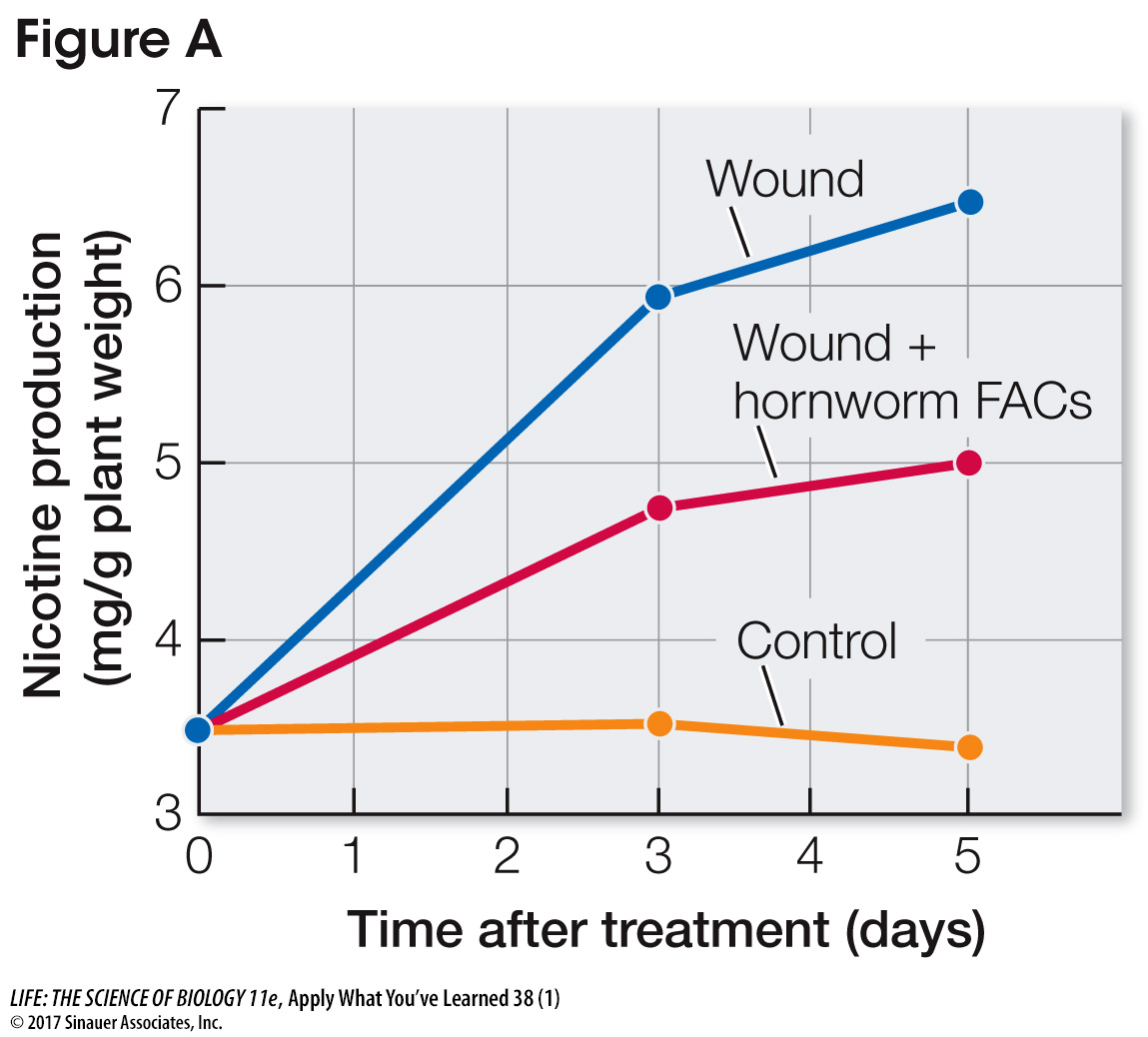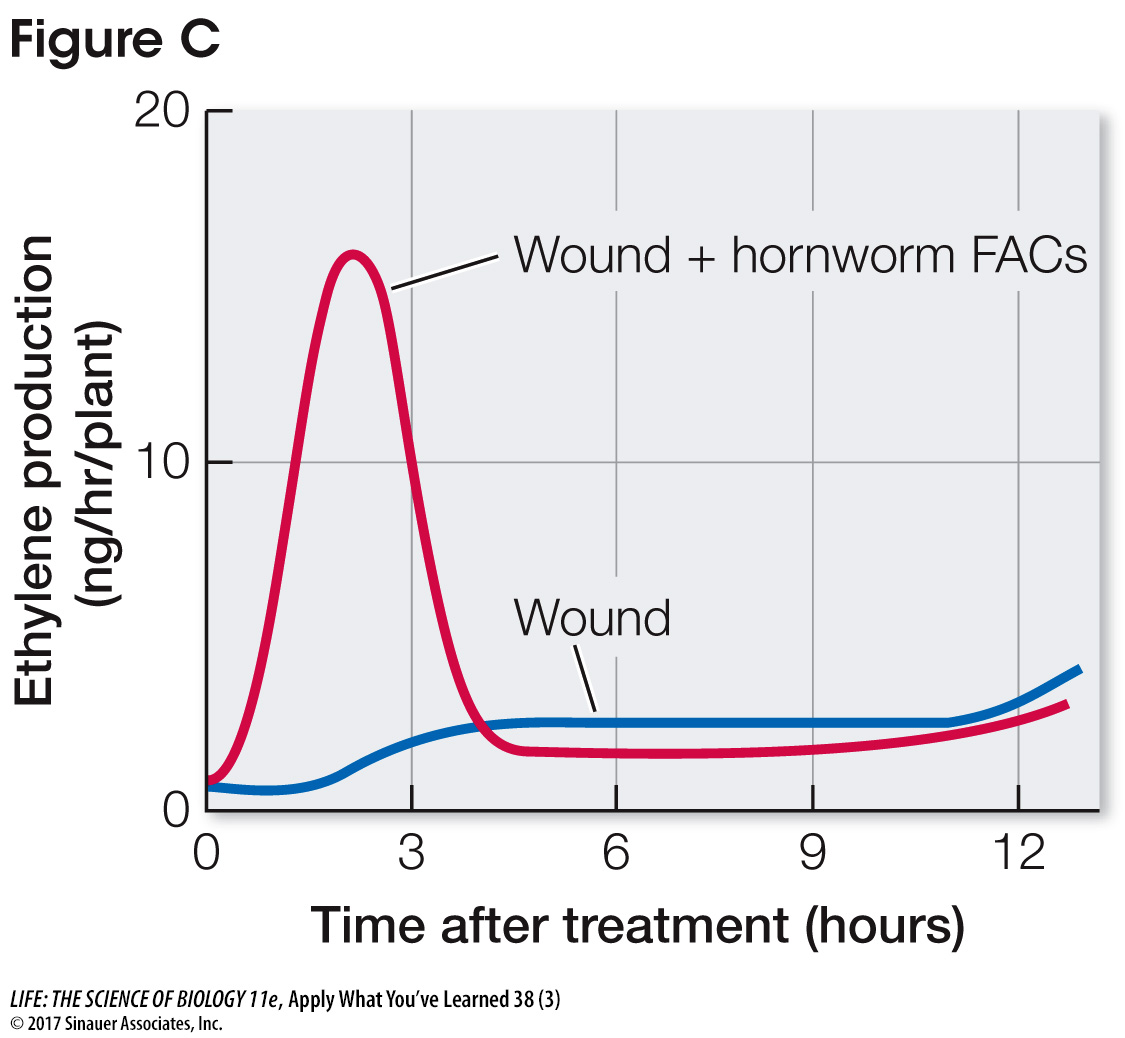Apply What You’ve Learned
822
Review
38.2 Secondary metabolites are plants’ constitutive chemical defenses against herbivory.
38.2 Herbivory induces plants to activate elicitors, which in turn activate signal transduction pathways.
38.2 The hormone jasmonic acid and its derivatives are key to the expression of many defenses against herbivory.
Original Paper: Halitschke, R., U. Schittko, G. Pohnert, W. Boland, and I. T. Baldwin. 2001. Molecular interactions between the specialist herbivore Manduca sexta and its natural host Nicotiana attenuata. Plant Physiology 125: 711–
Herbivores feed on the tobacco plant Nicotiana attenuata, which defends itself by producing secondary metabolites, most notably nicotine. Researchers did a series of experiments comparing two different types of responses in Nicotiana: response to a wound (mechanical damage), such as that done by animals, and response to herbivory by the caterpillar of the tobacco hornworm, Manduca sexta. They questioned whether the plant showed differences in its chemical defenses to these two types of predation.
The researchers exposed leaves on tobacco plants to physical wounds that might occur when a large animal chews the leaves. They also exposed the leaves to wounds along with hornworm secretions called FACs. This simulated the second condition, attack by a hornworm.
In one experiment, researchers measured nicotine production under both conditions and compared the results to those from untreated controls, as shown in Figure A.

In a second experiment, the researchers repeated the above two experimental conditions, but after a short period measured the concentration of the signaling molecule jasmonic acid (see Figure 38.5). The results are shown in Figure B.

The hornworm is able to eat tobacco without ill effects. One way it might be able to do this is by suppressing nicotine production in the plants. The hormone ethylene (see Figure 36.2) suppresses nicotine production. Thus, the researchers measured ethylene in the two conditions of predation, as shown in Figure C.

Questions
Question 1
Compare nicotine production in the two types of herbivory. What might account for the difference? Is nicotine production a constitutive or an induced response? Explain your answer.
The wound alone causes the release of a large amount of nicotine. Caterpillar herbivory (which includes the production of FACs) causes slightly less nicotine to be released. This suggests that FACs might have a slight inhibiting effect on nicotine release. Nicotine is a constitutive response; it is present naturally in the tobacco plant and does not have to be induced as a result of gene expression.
Question 2
What is the role of jasmonic acid in the plant’s response to herbivory? How does it differ from nicotine in its effects?
Jasmonic acid production is stimulated by the production of elicitors when herbivory occurs. Jasmonic acid then causes changes in gene expression that lead to the production of secondary metabolites, such as protein inhibitors (see Figure 38.5). These protein inhibitors limit the effectiveness of the herbivore. Jasmonic acid differs from nicotine in that it does not directly affect the herbivore but stimulates production of another substance that has the effect (i.e., jasmonic acid is an intermediate substance).
Question 3
In the graph illustrating jasmonic acid production, compare the plant’s response to the wound and to the wound + hornworm FACs. What does the difference in these responses suggest about the importance of the FACs produced by the caterpillar?
The burst of jasmonic acid production is much greater with the addition of FACs from the caterpillars. This stronger response suggests that FACs are elicitors that Nicotiana must recognize to trigger genetically controlled defense responses in the plant.
Question 4
Compare the production of jasmonic acid and ethylene under the two experimental conditions. What might explain the difference in these two responses?
Jasmonic acid triggers induced responses that limit hornworm herbivory in the tobacco plant. Ethylene suppresses nicotine production, making it easier for hornworm herbivory to occur. These are essentially opposite reactions. This could represent an example of the “evolutionary arms race” between plant and predator.